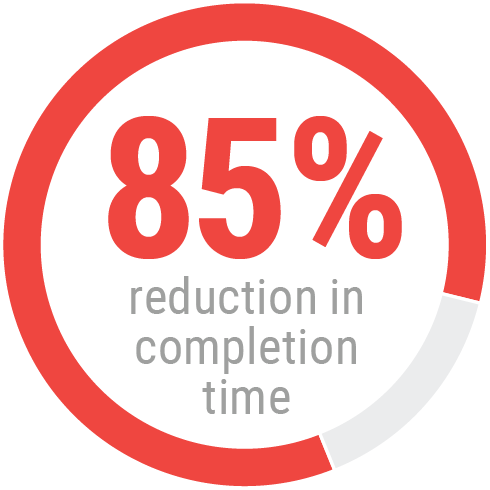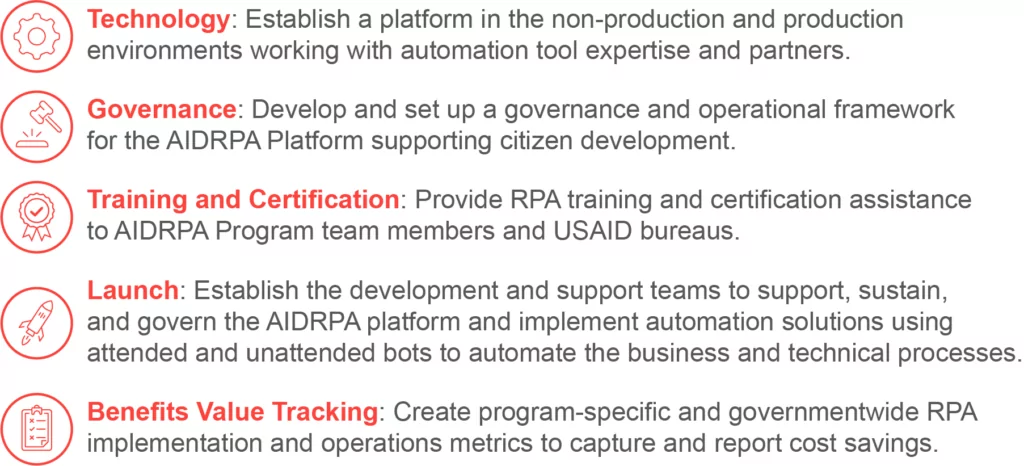How REI Systems built a centralized and standardized agency-wide Robotic Processing Automation (RPA) platform, which led to improved efficiency and streamlined processes in 5 key areas.
CHALLENGE
Our federal client’s mission is dedicated to promoting stability and democracy and driving economic growth globally. Our clients work with governments, non-governmental organizations, the private sector, and other stakeholders to achieve its goals. This agency is no stranger to RPA. Several bureaus and missions have used it to support and bolster overall innovation efforts. One proof of concept that used RPA to reduce the time it takes to process Personnel Action Records (PAR) inspired the agency to further explore how the technology could overhaul other HR business processes.
The agency set its sights on automating business processes with the help of these digital helpers. Noticing an increased demand for RPA, the Chief Information Office’s realized it lacked a comprehensive RPA program that could support burgeoning efforts to explore and implement RPA projects across the country. This program would provide technology, governance, training and certification assistance, and a benefits tracking tool to reduce manual effort. The agency lacked visibility of automation results and had fragmented training and technology
access. The RPA program aimed to provide a centralized solution to improve ROI and optimize processes. A lack of centralized ownership across departments hindered monitoring and improvement efforts. The agency also struggled with non-standard processes to create the
RPA solutions.
As a leader in Robotic Process Automation (RPA), REI Systems is helping government agencies optimize their business processes through RPA technology — outsourcing time-consuming, repetitive tasks to robots, and allowing employees to focus on higher-value work. We partnered
with USAID to deliver end-to-end work supporting its internal AIDRPA Centre of Excellence in its RPA goals and ultimately reclaiming tens of thousands of personnel hours.
Our work focused on five areas:
Additionally, REI held a key role in drafting the 5-year Centre of Excellence roadmap.
REI SOLUTION
Although invented in the early 2000s, RPA only recently gained momentum in government as a means of digital transformation and modernization. This technology interacts with digital systems just like a human and automates tasks, improves accuracy, and increases efficiency —
all while cutting operational costs. Its use is supported by the President’s Management Agenda, a blueprint for improving federal performance and accountability.
Our client wanted REI’s expertise on the technology, governance, and operating framework. The agency already had a production environment, and REI’s goal from a technology perspective was to set up UiPath in the development environment, review and update the production
environment configurations, and make the changes to these two environments from the security perspective. REI also successfully completed Security Assessment and Authorization and obtained the Authority to Operate (ATO).
UiPath’s RPA software allows organizations to automate repetitive, manual tasks. The platform creates bots that mimic humans and communicate with digital systems. The software’s arsenal of tools, such as visual process modeling and data extraction, makes it easy for organizations to take advantage of RPA.
REI used an Agile approach to establish the RPA technology platform, governance, operating framework, and security review. We also attended bi-weekly leadership meetings to report on project progress, key achievements, and potential risks and issues that needed leadership’s support.
In terms of AIDRPA Security Assessment and Authorization (SA&A), our team handled all aspects of it, including drafting important security documents. This proactive approach helped the Information System Security Officer (ISSO) finish the tasks ahead of schedule.
PARTNERSHIP IMPACT
Thanks to REI’s efforts, our client now has a secure and stable environment to develop RPA solutions. We took charge of ensuring a seamless user experience, both in development and production. This has opened doors for various business units to unleash their creativity and develop innovative new solutions on the platform.
With the establishment of a stable governance and operating framework, the agency is poised for automation success. The operating framework offers automation solutions at every turn, with a clear pathway through the stages of intake, prioritization, implementation, support, and maintenance. To ensure seamless progress, REI also created a set of templates for each step of the RPA journey.
REI’s implementation of a NegMemo bot to automate the contract modification process had noteworthy results. The old process was tedious and prone to errors, but the new RPA solution will save thousands of personnel hours and process up to 22,000 forms yearly with an 85% reduction in completion time. The automation was easy to use and received positive feedback from user acceptance testing.

To encourage user adoption, REI teams worked one-on-one with teams to help communicate what RPA is and is not, dispel fears that it would take away jobs, and shake down myths surrounding the technology — communicating RPA as digital assistants or helpers to allow humans to focus on more strategic work and less on mundane, administrative tasks.
In an age where digital privacy is a top concern, gaining user buy-in by effectively communicating what the RPA platform does — and doesn’t do — was another key to success. The solution, for example, doesn’t store data, but it can process data and place it into other systems.
At most organizations, completing the processes needed to meet modern security requirements and obtain ATOs are among the biggest challenges. Understanding how to overcome common hurdles to implementing RPA is a strength of the REI team.
In some organizations, legacy IT infrastructure can be an implementation challenge and may require workarounds to allow bots to access files and shared drives but not interact with off limits systems.
Testing the RPA in multiple interfaces from solution applications to mobile apps, required ongoing conversations between USAID and the REI team to understand how to meet the testing standard for the UiPath platform.
As a result of the success at USAID and elsewhere, interest in automation has increased in government, leading to a growing pipeline of RPA use cases. Form-heavy departments from IT to contracting offices, are among the areas where it is most implemented. But the use cases form successful automation are long and varied.
All in all, REI’s work has put USAID on the path to a brighter automation future, where RPA helps stamp out labor-intensive tasks so employees can focus on more important work. For organizations interested in realizing the promise of RPA, REI can work with them to gain a better understanding of their needs and provide direction and ideas to get on the road to automation — and ultimately, to working more effectively and efficiently.





